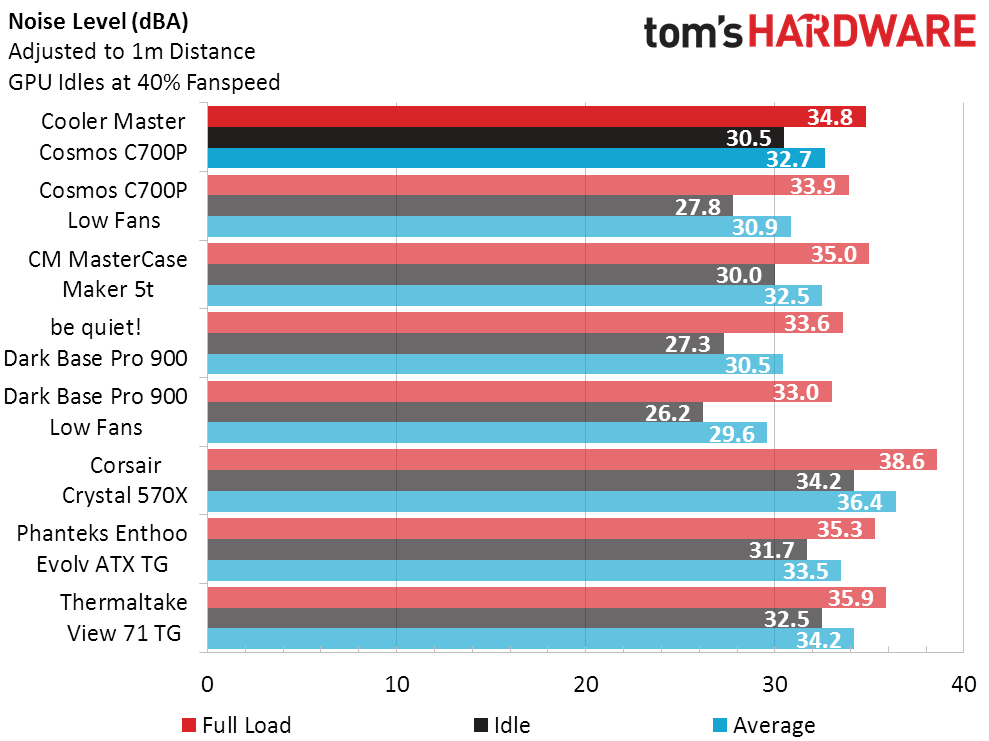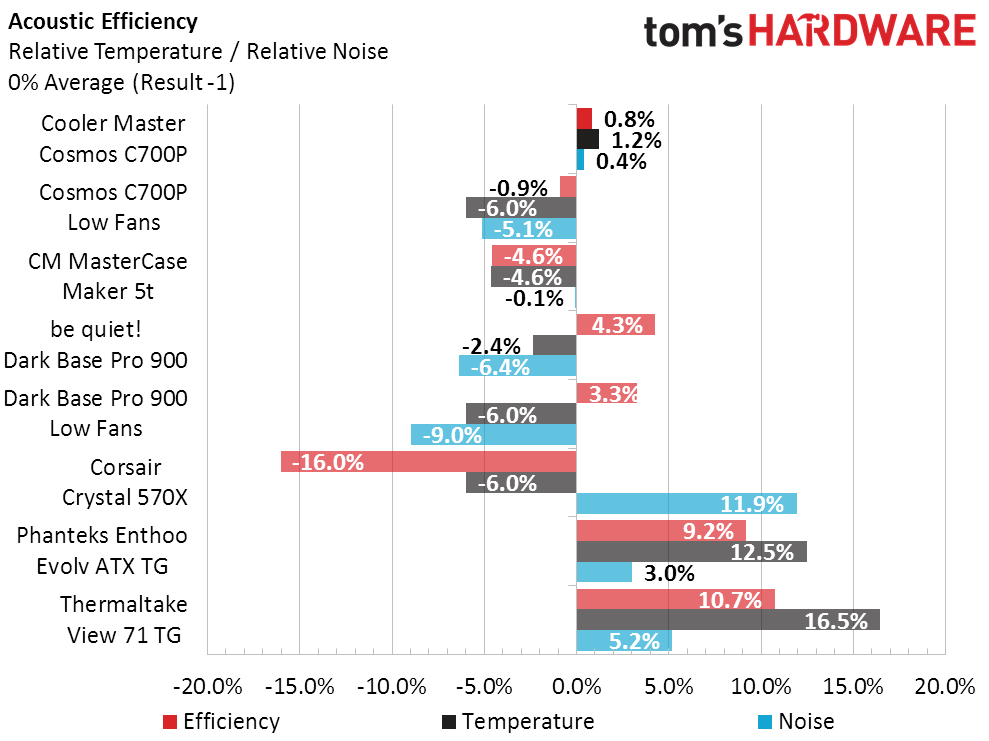Cooler Master Cosmos C700P XL-ATX Case Review
Why you can trust Tom's Hardware
Benchmarks & Conclusion
One of the reasons we use air cooling in case evaluations is that we really want to retain the as-delivered fan configuration, and this would be extra-important when evaluating cases where the fans are a major feature, such as the special RGB model used in the Crystal 570X. Another reason to use air cooling is that it lets us do a better job of evaluating airflow past the CPU socket, which is great for assuring that nearby components such as the voltage regulator are properly cooled. On the other hand, oversized cases sometimes allow air to flow around (rather than through) the cooler, and top-panel vents in front of the cooler bleed off airflow that the CPU cooler might have used.
To say that a poorly-vented top panel benefits a traditional CPU heatsink by forcing the air from the case's fans through that sink might be a cop-out, however; we can see that the two cases with the best CPU temperatures also have the best GPU temperatures. The C700P cools better than its most-expensive rivals but loses to the cheaper ones.
Two of the cases that cooled worse than the C700P also had lower noise, so overall performance levels are likely similar. The Crystal 570X stood out as being both hot and noisy, which is a huge disappointment given how much I liked the design of that case. The two best-cooling cases, Enthoo Evolv ATX TG and View 71 TG, are both noisier than the Cosmos C700P.
Cooling is one way to measure performance. Noise levels are another. Comparing cooling to noise gives us an overall performance rating labeled “acoustic efficiency” and better known as cooling-to-noise ratio. Lower noise helps the Dark Base Pro 900 beat the Cosmos C700P at all fan settings, while better cooling puts the View 71 TG and Enthoo Evolv ATX TG on top.
Performance value charts always penalize pricey non-performance features such as a curved, tempered-glass panel that’s difficult to produce and RGB LED hardware that adds nothing but appearance (and perhaps a little heat). Anyone who can afford those features and really wants them should ignore the chart, even though value-seekers should also feel free to use it when attempting to justify not having those things.
Production quality is another factor that doesn’t show up in any of our charts, yet only one of the cases in these charts has noteworthy deficiencies: The View 71 TG’s panel mounting pegs didn’t line up perfectly with the holes, and the threaded inserts of those holes weren’t perfect either; one was crooked and another cross-threaded. We might have been willing to give the C700P some kind of award based on quality and features if it had just offered similar performance.
Interested Cosmos buyers might consider its large radiator support and fully-modular design. One could, for example, put two triple-fan radiators on the bottom and front, using both as intakes, by moving the power supply to the top. Those who tell you this is a bad idea due to heated air entering the power supply probably aren’t thinking about the volume of air two triple-fan radiators can move when all six fans are used as intakes, and its effect on minimizing temperature deltas.
Get Tom's Hardware's best news and in-depth reviews, straight to your inbox.
MORE: Best Cases
MORE: All Case Content
-
shrapnel_indie Case has some looks. Has four USB on the front. Has flexibility. Color me impressed on that, Cooling? not so impressed. Price? Lian-Li territory pricing: Too rich for my blood. So, unless they have a sale on it that puts it about 66% off when its time for me to grab a new case... I'll pass.Reply -
johnsaar2005 You only reviewed this from an air cooling perspective. If your going to fully review a case you need to go over water cooling custom loops and enclosed aio. People who are interested in this case are most likely not going to use stock fans and will purchase or have better available from previous builds. This review seems rushed.Reply -
Crashman Reply
They're all a little rushed these days, but we've brought on another case editor to ease the burden.20219978 said:You only reviewed this from an air cooling perspective. If your going to fully review a case you need to go over water cooling custom loops and enclosed aio. People who are interested in this case are most likely not going to use stock fans and will purchase or have better available from previous builds. This review seems rushed.
To be fair, cases like this would need to be tested two ways, and the second way would require a completely different standardized cooling system. Standardizing is tough when you can't pick a format:Is it fair to test a 3x 140mm case with a 2x 120mm cooler, or should 2x 120mm cases be excluded from the second test?
-
milkod2001 Looks great but it is a monster case. At half size to accommodate CPU, 1x GPU, 1x SDD and 2x HDDs comfortably using the very same designs at $150 would definitely make more people interested in.Reply -
thundervore CoolerMaster do not get it. 90% of the people out there do not want a monster case anymore, its not the year 2000! No one is going to buy this throw in 2x 420 radiators an eATX board with triple GPU and water cool everything creating a 50LB monster when they can go AIO with a ITX and AIO GPU. Everyone is trying to go smaller with more power. If this case was microATX with 280 rad support then it will work but this case will only be seen on showroom floors, or on review sites until the next thing some out.Reply -
Sam Hain Christ on a bike! 47.9lbs, without innards (hardware) being installed. I feel L5, L4 and L3 being ruptured just having to heave this monolith from the floor to bench (even with using proper lifting technique) to begin breathing life into it.Reply -
Crashman Reply
I had to carry it from my build bench to my photo bench and back, with another 15 pounds or so of hardware installed :D20224388 said:Christ on a bike! 47.9lbs, without innards (hardware) being installed. I feel L5, L4 and L3 being ruptured just having to heave this monolith from the floor to bench (even with using proper lifting technique) to begin breathing life into it.
-
Sam Hain Reply20224412 said:
I had to carry it from my build bench to my photo bench and back, with another 15 pounds or so of hardware installed :D20224388 said:Christ on a bike! 47.9lbs, without innards (hardware) being installed. I feel L5, L4 and L3 being ruptured just having to heave this monolith from the floor to bench (even with using proper lifting technique) to begin breathing life into it.
You sir, are an Olympian! :bounce:




